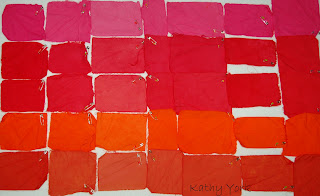24" x 60"
I was inspired to create this quilt by my morning drive with my daughter to school. She is a transfer student, and it's a bit of a drive for us. At first, we used to go on the highway. Then I discovered the "back route" on a particularly heavy traffic morning, and since then, it has become the preferred route. It is not a quick route, but it is scenic and calm. A perfect start to our mornings together, and one of my favorite shared times with her.
So as the image crept into my mind, I didn't know how to represent it. So many choices! Then I saw this blog post by Deidre Adams, Evolution of a Commission (be sure to look at all 6 parts!). I love her work! It is so viscerally appealing. I wanted to give her process a try to see what would happen. I was a bit nervous to start. I didn't want my work to look too much like hers if I used her techniques (Ha! not to worry!!). It turns out that my voice over-rides the process. My way of thinking and expressing is just much more....concrete maybe? or discrete, in terms of obvious objects....
Let's start with the car. I drew it on Photoshop first. Eventually, I painted some fabric with white paint. Then I traced my image from the Photoshop print out with a Sharpie pen. Then I put more white paint on top of that. It sandwiched the Sharpie ink between layers of paint, and then the line I made was also less obvious, and acted more as a guide for subsequent painting. And, then I painted it, and used it as a block in the construction of the quilt top.
I chose fabrics that were already the color palette I was aiming for. The next step was sandwiching the quilt layers, and then massive machine quilting. I really thought I could quilt it in a day, but it took 3 long days to quilt.
 |
| quilting as seen from the back |
So, I added several layers of white acrylic paint. It was harder to apply than I thought it would be, and eventually, I just started pouring it on the quilt top. Did I mention that I was nervous about this step?
I was still working out the design, as it needed the deer. I decided to screen print them, directly onto the quilted surface. Okay, that didn't work either. Plan B....Print the deer separately on some cloth.
These were later cut apart, and fused to the quilt surface. It was nice because I got to move them around a bit before deciding their placements. Then I painted over them. Here is another process shot with a few details. I love the way the paint makes the surface texture just pop!
The last step was adding the words. On the way to school we typically count the deer. If it is a low deer count morning, we will practice spelling, or math. I had wanted to incorporate this in the quilt, but I didn't quite know how to. My experience of screen printing on the quilted surface didn't go so well, so I was a bit nervous about trying to write on it. I gathered my wits and a white Sharpie pen. It worked beautifully!
I added letters with dots between them to indicate the spelling. And the words I chose were real spelling words, but also words signifcant and representative of my daughter and her experience at school. This is a meaningful quilt for me because my daughter is finishing up her last year at this school. Next year she will be closer, and will take the bus to school. I will miss our morning drives together! but it already has me thinking...what new rituals will replace this one to celebrate our time together?















